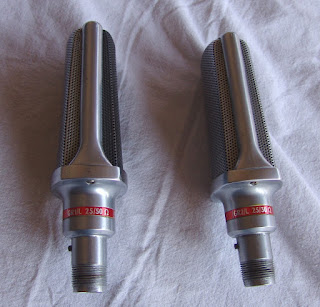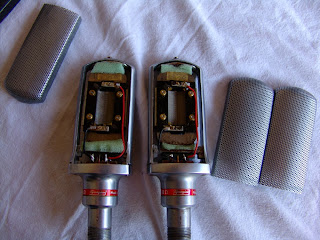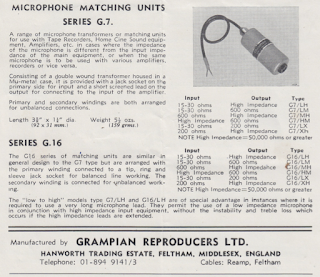It is time again for microphone of the month, and for May we have these lovely Grampian ribbons.
 |
| Grampian ribbon mics |
Grampian mics come in a variety of model names and numbers which we will try to decypher. These were made in the 1960s and 70s by Grampian Reproducers Ltd, of Feltham in Middlesex, England.
 |
| Grampian GR1/L and GR2/L ribbon mics |
The mics are labeled GR (“Grampian Ribbon”), followed by a number and a letter. The GR1 designation was used for the semi-cardioid version, and the GR2 is the ‘normal’ figure-8 pattern. The letter shows the impedance of the mic, set by the output transformer winding. They come in Low, Medium, High, and ‘X’ flavours – the letter codes are as follows:
GR1/L and GR2/L … 30 ohms
GR1/X and GR2/X … 200 ohms
GR1/M and GR2/M … 600 ohms
GR1/H and GR2/H … 50K ohms
Here is a rather wobbly scan of the original Grampian data sheet.
The GR1 usually has a silver grill at the front, and a black one at the rear to show its asymmetry, whereas the GR2 has two silver grills. However, inside there is very little real difference between the two models, and any cardioidness* is imposed by additional foam padding around the rear of the ribbon. This foam usually depolymerises over the 40 years or so since manufacture, and the mics will typically fall apart when opened. If the mics have been stored for a long time they will require careful cleaning and new foam suspension before being put back into use.
The mics have a small thin ribbon, held in a removable plastic frame for ease of service. In that respect they are similar to the Reslos and Film Industries mics with which they undoubtedly competed. Unlike the Reslo and FI mics, the symmetrical magnet arrangement means that the GR2 has a true figure-8 response, and are suitable for Blumlein pair or a side mic in a mid-side array.
The internal transformers have a tendency to break, particularly on the H models which have very thin wires. If the break is in the right place the transformer can be repaired, but a rewind may be necessary.
 |
| Grampian plugs |
External matching transformers were also available, in case one needed to connect to an input of a different impedance. These are still handy for getting a bit more level out of the 30 ohm models.
These were mid-price microphones when they were made. I have a Grampian price list from June 1976, and the GR1 & 2 microphones were priced at £32.05 (plus tax) in a wooden instrument case, and £27.55 in a cardboard box. This would translate today as £180 to £334 plus tax, which would buy one of the better Chinese ribbons or a Beyer M260.
* I made this word up.



